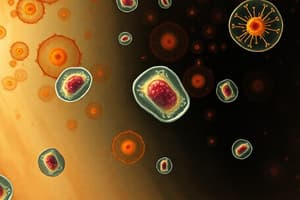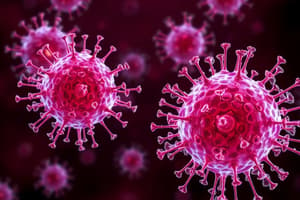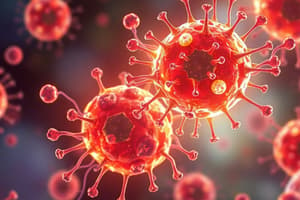Podcast
Questions and Answers
What characterizes adaptive immunity compared to innate immunity?
What characterizes adaptive immunity compared to innate immunity?
- Immediate response to pathogens
- Development through the thymus
- Specificity and memory (correct)
- Presence of chemical barriers
Which of the following is primarily responsible for attacking intracellular pathogens during the adaptive immune response?
Which of the following is primarily responsible for attacking intracellular pathogens during the adaptive immune response?
- Neutrophils
- B cells
- Helper T cells
- Cytotoxic T cells (correct)
What is the primary role of B cells in the adaptive immune response?
What is the primary role of B cells in the adaptive immune response?
- Regulate cellular immunity
- Produce antibodies (correct)
- Directly kill infected host cells
- Act as antigen-presenting cells
What happens to neutrophils during the immune response?
What happens to neutrophils during the immune response?
What is the composition of pus in the context of an immune response?
What is the composition of pus in the context of an immune response?
What is the primary role of T cells in the immune response?
What is the primary role of T cells in the immune response?
Which cells are responsible for producing plasma cells?
Which cells are responsible for producing plasma cells?
Which of the following best describes the function of macrophages?
Which of the following best describes the function of macrophages?
What differentiates primary lymphatic organs from secondary lymphatic organs?
What differentiates primary lymphatic organs from secondary lymphatic organs?
Dendritic cells share a similar function with which other type of lymphoid cell?
Dendritic cells share a similar function with which other type of lymphoid cell?
Which of these is considered an antigen?
Which of these is considered an antigen?
What is the primary function of reticular cells in lymphoid organs?
What is the primary function of reticular cells in lymphoid organs?
What is the primary function of the thymus?
What is the primary function of the thymus?
Which of the following components is NOT found in the cortex of the thymus?
Which of the following components is NOT found in the cortex of the thymus?
What percentage of immature T cells survive the positive selection process in the thymus?
What percentage of immature T cells survive the positive selection process in the thymus?
How does the hormonal function of thymocytes affect lymphocytes?
How does the hormonal function of thymocytes affect lymphocytes?
What happens to the thymus as a person ages?
What happens to the thymus as a person ages?
Which type of cells assists in the maturation of T cells in the thymus?
Which type of cells assists in the maturation of T cells in the thymus?
What is a distinguishing feature of the stroma in the thymus?
What is a distinguishing feature of the stroma in the thymus?
Which cells are involved in the clearance of dead T cells within the thymus?
Which cells are involved in the clearance of dead T cells within the thymus?
What characterizes the medulla of the thymus compared to the cortex?
What characterizes the medulla of the thymus compared to the cortex?
What role do iron-binding proteins play in the immune response?
What role do iron-binding proteins play in the immune response?
Which of the following describes the function of Natural Killer (NK) cells?
Which of the following describes the function of Natural Killer (NK) cells?
What is the first step in the phagocytosis process?
What is the first step in the phagocytosis process?
What are the four signs and symptoms of inflammation?
What are the four signs and symptoms of inflammation?
During inflammation, which substances increase blood vessel permeability?
During inflammation, which substances increase blood vessel permeability?
What is the primary function of antimicrobial proteins (AMPs)?
What is the primary function of antimicrobial proteins (AMPs)?
What occurs during the emigration phase of inflammation?
What occurs during the emigration phase of inflammation?
How do complements contribute to the immune response?
How do complements contribute to the immune response?
Which component is NOT part of the phagocytosis process?
Which component is NOT part of the phagocytosis process?
What is the primary function of red pulp in the spleen?
What is the primary function of red pulp in the spleen?
Which component is NOT a part of the spleen's stroma?
Which component is NOT a part of the spleen's stroma?
What role do the macrophages in the spleen play?
What role do the macrophages in the spleen play?
During which stage of life does the spleen primarily produce blood cells?
During which stage of life does the spleen primarily produce blood cells?
Which type of lymphocytes are predominantly found in the white pulp of the spleen?
Which type of lymphocytes are predominantly found in the white pulp of the spleen?
What is the main function of the spleen in the immune system?
What is the main function of the spleen in the immune system?
What does the spleen store for later use, mentioned in its function?
What does the spleen store for later use, mentioned in its function?
How much of the body's platelet supply can the spleen store?
How much of the body's platelet supply can the spleen store?
What is the process by which the spleen helps cleanse the blood?
What is the process by which the spleen helps cleanse the blood?
Which is a function of spleen macrophages?
Which is a function of spleen macrophages?
Flashcards
Lymphocytes
Lymphocytes
Specialized white blood cells that are critical for the immune response. They identify and target specific pathogens or foreign substances.
T cells
T cells
A type of lymphocyte responsible for managing the immune response and directly attacking infected or abnormal cells.
B cells
B cells
A type of lymphocyte responsible for producing antibodies, which neutralize and eliminate pathogens.
Antigen
Antigen
Signup and view all the flashcards
Macrophages
Macrophages
Signup and view all the flashcards
Dendritic cells
Dendritic cells
Signup and view all the flashcards
Reticular cells
Reticular cells
Signup and view all the flashcards
What is the thymus?
What is the thymus?
Signup and view all the flashcards
How is the thymus structured?
How is the thymus structured?
Signup and view all the flashcards
What's in the thymus cortex?
What's in the thymus cortex?
Signup and view all the flashcards
What's in the thymus medulla?
What's in the thymus medulla?
Signup and view all the flashcards
How is the thymus unique?
How is the thymus unique?
Signup and view all the flashcards
What makes up the thymus's framework?
What makes up the thymus's framework?
Signup and view all the flashcards
What role do epithelial cells play in the thymus?
What role do epithelial cells play in the thymus?
Signup and view all the flashcards
What happens to T cells in the thymus cortex?
What happens to T cells in the thymus cortex?
Signup and view all the flashcards
What happens to the thymus over time?
What happens to the thymus over time?
Signup and view all the flashcards
What is the spleen?
What is the spleen?
Signup and view all the flashcards
What is the stroma of the spleen?
What is the stroma of the spleen?
Signup and view all the flashcards
What is the parenchyma of the spleen?
What is the parenchyma of the spleen?
Signup and view all the flashcards
What is the white pulp of the spleen?
What is the white pulp of the spleen?
Signup and view all the flashcards
What type of cells are found in the white pulp of the spleen?
What type of cells are found in the white pulp of the spleen?
Signup and view all the flashcards
What is the red pulp of the spleen?
What is the red pulp of the spleen?
Signup and view all the flashcards
What is the role of macrophages in the red pulp?
What is the role of macrophages in the red pulp?
Signup and view all the flashcards
What is a function of the spleen related to platelets?
What is a function of the spleen related to platelets?
Signup and view all the flashcards
What function does the spleen have during fetal development?
What function does the spleen have during fetal development?
Signup and view all the flashcards
What is one of the main functions of the spleen related to blood platelets?
What is one of the main functions of the spleen related to blood platelets?
Signup and view all the flashcards
What is emigration?
What is emigration?
Signup and view all the flashcards
What is adaptive immunity?
What is adaptive immunity?
Signup and view all the flashcards
What is an antigen?
What is an antigen?
Signup and view all the flashcards
What are cytotoxic T cells?
What are cytotoxic T cells?
Signup and view all the flashcards
What is antibody-mediated immunity?
What is antibody-mediated immunity?
Signup and view all the flashcards
Complement Proteins
Complement Proteins
Signup and view all the flashcards
Iron-binding Proteins
Iron-binding Proteins
Signup and view all the flashcards
Antimicrobial proteins (AMPs)
Antimicrobial proteins (AMPs)
Signup and view all the flashcards
Natural Killer (NK) cells
Natural Killer (NK) cells
Signup and view all the flashcards
Phagocytes
Phagocytes
Signup and view all the flashcards
Phagocytosis
Phagocytosis
Signup and view all the flashcards
Inflammation
Inflammation
Signup and view all the flashcards
Vasodilation and Increased Blood Vessel Permeability
Vasodilation and Increased Blood Vessel Permeability
Signup and view all the flashcards
Emigration of Phagocytes
Emigration of Phagocytes
Signup and view all the flashcards
Tissue Repair
Tissue Repair
Signup and view all the flashcards
Study Notes
Lymphatic System
- The lymphatic system consists of lymph, lymphatic vessels, structures, and organs containing lymphatic tissue, and red bone marrow.
- The lymphatic system's functions include draining excess interstitial fluid, transporting dietary lipids, and carrying out immune responses.
- Lymphatic vessels begin as lymphatic capillaries, which are closed at one end. They unite to form larger vessels, resembling veins in structure but with thinner walls and more valves.
- Lymphatic vessels pass through lymph nodes and encapsulated organs with masses of B and T cells.
- Lymphatic capillaries are slightly larger in diameter than blood capillaries and have a unique one-way structure. Anchoring filaments pull openings wider when interstitial fluid accumulates.
Immunity or Resistance
- Immunity or resistance involves the ability to ward off damage or disease, and there are two types of immunity: innate and adaptive.
- Innate, or nonspecific immunity, is present at birth and has no specific recognition of invaders. It includes a first and second line of defense.
- Adaptive, or specific immunity, involves specific recognition of invaders with a memory component.
Lymphoid Cells
- Lymphocytes are the main cells involved in the immune response, with two main types: T cells and B cells.
- T cells manage the immune response and attack/destroy foreign cells.
- B cells produce plasma cells, which secrete antibodies that immobilize antigens.
- Other lymphoid cells include macrophages (phagocytize foreign substances and help activate T cells), dendritic cells (similar to macrophages, gathering and transporting antigens to lymph nodes), and reticular cells (fibroblast-like cells supporting other cell types in lymphoid organs).
Lymphatic Tissues and Organs
- Lymphatic tissues and organs are grouped into two categories based on function: primary and secondary.
- Primary lymphatic organs (red bone marrow and thymus) are sites where stem cells divide and become immunocompetent (able to produce a normal immune response).
- Secondary lymphatic organs (lymph nodes, spleen, lymphatic nodules) are sites where most immune responses occur.
Lymphoid Organs
- Lymphoid organs include tonsils (in the pharynx), thymus (in the thorax), spleen (curves around the left side of the stomach), Peyer's patches (in the intestine), and the appendix.
Thymus
- The thymus contains thymic lobes with an outer cortex and inner medulla.
- The cortex has densely packed lymphocytes and scattered macrophages.
- The medulla has fewer lymphocytes and thymic (Hassall's) corpuscles.
- The thymus differs from other lymphoid organs by its function strictly in T lymphocyte maturation and lack of direct antigen-fighting.
- The thymus stroma consists of star-shaped epithelial cells (not reticular fibers).
- Thymocytes secrete hormones to stimulate lymphocytes for immunocompetence.
Lymph Nodes
- Lymph nodes are located along lymphatic vessels, scattered throughout the body, and have a fibrous capsule, trabeculae, and reticular fibers and fibroblasts as stroma.
- The parenchyma, the functional part, includes an outer cortex (aggregates of B cells forming lymphatic nodules—a site of plasma cell and memory B cell formation), an inner cortex (mainly T cells and dendritic cells), and a medulla (containing B cells, antibody-producing plasma cells from the cortex, and macrophages). Lymph flows through nodes in one direction.
- Lymph nodes are filtering stations for foreign substances, which are trapped and destroyed by macrophages or through the immune response of lymphocytes. There are two basic functions filtration and immune system activation.
- Lymph nodes are bean-shaped and surrounded by a fibrous capsule. Trabeculae extend inward, dividing the node into compartments. Nodes have a cortex and medulla. The cortex contains follicles with germinal centers (where B cells divide), dendritic cells, and superficial T cells. The medulla has medullary cords (B cells and plasma cells) and medullary sinuses.
Spleen
- The spleen is the largest single mass of lymphatic tissue in the body. Its stroma is composed of a capsule, trabeculae, reticular fibers, and fibroblasts. The parenchyma includes the white pulp (lymphatic tissue, including lymphocytes and macrophages), where B and T cells carry out immune functions, and the red pulp (blood-filled venous sinuses and splenic cords).
- The spleen removes ruptured, worn out, or defective blood cells. It stores up to one-third of the body's platelet supply and produces blood cells during fetal life. Its functions include lymphocyte proliferation, immune surveillance and response, blood cleansing, and storage.
Lymphatic Nodules
- Lymphatic nodules lack a capsule, are scattered throughout the lamina propria of mucous membranes, and include mucosa-associated lymphatic tissue (MALT) in the respiratory tract.
- Some lymphatic nodules are larger (tonsils, Peyer's patches, appendix).
Antigen Processing
- B cells can recognize and bind to antigens in lymph, interstitial fluid, or blood plasma.
- T cells only recognize fragments of antigens that are processed and presented in a certain way.
- Antigen-presenting cells (APCs) process antigens, and then present them to T cells.
- Endogenous and exogenous antigens are processed differently.
Cell-Mediated Immunity
- Cell-mediated immunity (CMI) involves cytotoxic T cells, which directly attack invading antigens, particularly effective against intracellular pathogens (viruses, bacteria, fungi), some cancer cells, and foreign tissue transplants.
- CMI involves cells attacking cells.
- Helper T cells aid in both cell-mediated and antibody-mediated immunity.
Antibody-Mediated Immunity
- Antibody-mediated immunity (AMI) involves B cells transforming into plasma cells producing antibodies (Abs) or immunoglobulins.
- Antibodies work against extracellular pathogens in fluids outside cells.
- Helper T cells aid in AMI.
Immunological Memory
- Thousands of memory cells exist after the initial encounter with antigen.
- Next time the antigen appears, memory cells can proliferate and differentiate within hours.
- Antibody titer is a measure of immunological memory (amount of Abs in the serum).
- Secondary response is faster and stronger than the primary response.
Self-Recognition and Self-Tolerance
- T cells must be able to recognize their own MHC molecules and lack reactivity to peptide fragments from their own proteins (self-tolerance).
- Failure to meet self-tolerance rules can lead to autoimmune diseases.
- T cells in the thymus develop self-recognition via positive selection and eliminate T cells that don't recognize self-MHC.
- Negative selection eliminates self-reacting T cells.
Studying That Suits You
Use AI to generate personalized quizzes and flashcards to suit your learning preferences.
Related Documents
Description
This quiz explores key concepts of adaptive immunity, comparing it with innate immunity. Test your understanding of the roles of various immune cells, including B cells, T cells, and macrophages, as well as the functions of lymphatic organs and responses during an immune reaction.




